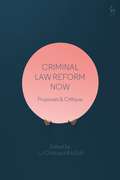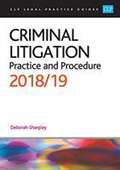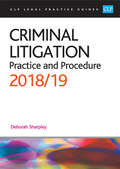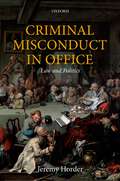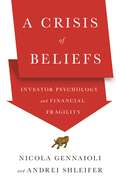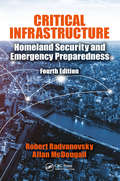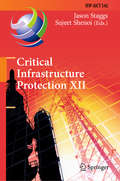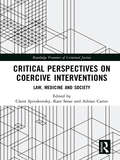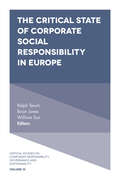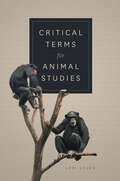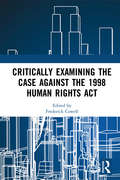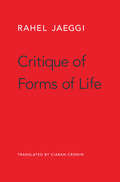- Table View
- List View
Criminal Law Reform Now: Proposals & Critique
by Dr J J Child R A DuffIf you could change one part of the criminal law, what would it be? The editors put this question to nine leading academics and practitioners. The first nine chapters of the collection present their responses in the form of legal reform proposals, with topics ranging across criminal law, criminal justice and evidence – including confiscation, control orders, criminal attempts, homicide, assisted dying, the special status of children, time restrictions on prosecution, the right to silence, and special measures in court. Each chapter is followed by a comment from a different author, providing an additional expert view on each reform proposal. Finally, the last two chapters broaden the debate to discuss criminal law reform in general, examining various reform bodies and mechanisms across England, Wales and Scotland. Criminal Law Reform Now highlights and explores the current reform debates that matter most to legal experts, with each chapter making a case for positive change.
Criminal Litigation: Practice And Procedure 2018/19 (PDF)
by Deborah SharpleyThis book has been written principally for students studying criminal litigation as part of the Legal Practice Course (LPC). The book is designed so that it may be used both by students studying the basics of criminal litigation on the compulsory part of the LPC, and also students studying advanced criminal litigation as an elective subject. Although intended primarily as a student text, it is hoped that the level of detail in the book will also make it of use to trainee and newly-qualified solicitors. The book concentrates on the practice and procedure of criminal litigation, from the initial investigations carried out by the police through to appeals following conviction. Matters of substantive criminal law arise only where necessary to illustrate a point of practice or procedure, or in the context of the law of evidence. The book employs a case study to illustrate the most common documents that are created during the course of criminal proceedings, and how such documents should be drafted. In addition, worked examples are used to explain complex points of procedure and evidence. Flowcharts are provided, where appropriate, to demonstrate procedures. Each chapter starts with a section entitled ‘Learning Outcomes’, listing the key points covered. Appendix B includes extracts from the Magistrates’ Court Sentencing Guidelines.
Criminal Litigation: Practice And Procedure 2018/19
by Deborah SharpleyThis book has been written principally for students studying criminal litigation as part of the Legal Practice Course (LPC). The book is designed so that it may be used both by students studying the basics of criminal litigation on the compulsory part of the LPC, and also students studying advanced criminal litigation as an elective subject. Although intended primarily as a student text, it is hoped that the level of detail in the book will also make it of use to trainee and newly-qualified solicitors. The book concentrates on the practice and procedure of criminal litigation, from the initial investigations carried out by the police through to appeals following conviction. Matters of substantive criminal law arise only where necessary to illustrate a point of practice or procedure, or in the context of the law of evidence. The book employs a case study to illustrate the most common documents that are created during the course of criminal proceedings, and how such documents should be drafted. In addition, worked examples are used to explain complex points of procedure and evidence. Flowcharts are provided, where appropriate, to demonstrate procedures. Each chapter starts with a section entitled ‘Learning Outcomes’, listing the key points covered. Appendix B includes extracts from the Magistrates’ Court Sentencing Guidelines.
Criminal Misconduct in Office: Law and Politics (Oxford Monographs on Criminal Law and Justice)
by Jeremy HorderShould the criminal law be used to deter and punish corruption in politics: from employing family members at public expense to improper spending on elections, lobbying, and cronyism? How did so many MPs avoid facing charges after the 2009 government expenses scandal? In this book, Jeremy Horder tackles these questions and more. As well as offering the first treatment of the history, philosophy, and politics of the application of the offence of misconduct in office to Members of Parliament in England and Wales, Horder explains how political corruption might be dealt with in future, and how politicians could be held accountable for their actions so that they are deterred from betraying the public's trust. Use of the criminal law should not be the sole or even the main way to remedy all corruption in politics. Nevertheless, for too long the offence of misconduct in a public office has had an ambiguous status in the political realm. If we are to preserve the good health of government it must be seen as a constitutional fundamental. A charge of misconduct provides a way in which corrupt conduct on the part of legislators can be punished with an appropriate label, holding them to account for the misuse of power by reference to the standards of ordinary people. When other - civil law or regulatory - means prove insufficient, it should be possible for ordinary members of a jury, and not for Parliamentarians or other officials, to decide whether, for example, the expenditure of public money on legislators' private income and benefits amounts to a criminal abuse of the public's trust. This book offers an authoritative and accessible account of a 'bottom-up' (jury standards-led), as opposed to a 'top-down' (officials applying their own standards), approach to the role of the criminal law in constitutional contexts.
The Criminal Process
by Andrew Ashworth Liz Campbell Mike RedmayneThe fifth edition of The Criminal Process continues in the tradition of previous editions in providing an insightful and stimulating analysis of the key issues in criminal processes and procedures. The authors draw on arguments from the law, research, policy, and principle, to present an authoritative overview of this area of study.
A Crisis of Beliefs: Investor Psychology and Financial Fragility
by Nicola Gennaioli Andrei ShleiferHow investor expectations move markets and the economyThe collapse of Lehman Brothers in September 2008 caught markets and regulators by surprise. Although the government rushed to rescue other financial institutions from a similar fate after Lehman, it could not prevent the deepest recession in postwar history. A Crisis of Beliefs makes us rethink the financial crisis and the nature of economic risk. In this authoritative and comprehensive book, two of today’s most insightful economists reveal how our beliefs shape financial markets, lead to expansions of credit and leverage, and expose the economy to major risks.Nicola Gennaioli and Andrei Shleifer carefully walk readers through the unraveling of Lehman Brothers and the ensuing meltdown of the US financial system, and then present new evidence to illustrate the destabilizing role played by the beliefs of home buyers, investors, and regulators. Using the latest research in psychology and behavioral economics, they present a new theory of belief formation that explains why the financial crisis came as such a shock to so many people—and how financial and economic instability persist.A must-read for anyone seeking insights into financial markets, A Crisis of Beliefs shows how even the smartest market participants and regulators did not fully appreciate the extent of economic risk, and offers a new framework for understanding today’s unpredictable financial waters.
A Crisis of Beliefs: Investor Psychology and Financial Fragility
by Nicola Gennaioli Andrei ShleiferHow investor expectations move markets and the economyThe collapse of Lehman Brothers in September 2008 caught markets and regulators by surprise. Although the government rushed to rescue other financial institutions from a similar fate after Lehman, it could not prevent the deepest recession in postwar history. A Crisis of Beliefs makes us rethink the financial crisis and the nature of economic risk. In this authoritative and comprehensive book, two of today’s most insightful economists reveal how our beliefs shape financial markets, lead to expansions of credit and leverage, and expose the economy to major risks.Nicola Gennaioli and Andrei Shleifer carefully walk readers through the unraveling of Lehman Brothers and the ensuing meltdown of the US financial system, and then present new evidence to illustrate the destabilizing role played by the beliefs of home buyers, investors, and regulators. Using the latest research in psychology and behavioral economics, they present a new theory of belief formation that explains why the financial crisis came as such a shock to so many people—and how financial and economic instability persist.A must-read for anyone seeking insights into financial markets, A Crisis of Beliefs shows how even the smartest market participants and regulators did not fully appreciate the extent of economic risk, and offers a new framework for understanding today’s unpredictable financial waters.
A Crisis of Democratic Accountability: Public Libel Law and the Checking Function of the Press
by Randall StephensonThis book undertakes a comparative study of the public interest and political speech defences in defamation law, particularly from the perspective of the misuse of democratic free expression justifications. Specifically, it argues that the law and legal approaches taken by leading courts and legislatures in the UK, Australia, New Zealand, Canada, and the United States – five common law comparators – are undertheorised, lack adequate criteria for determining the correct form of the defence, and would benefit from a more precise understanding of 'democracy', 'accountability', and 'representation'. The book will be of great interest to scholars of free speech, defamation and public law.
Critical Information Infrastructures Security: 12th International Conference, CRITIS 2017, Lucca, Italy, October 8-13, 2017, Revised Selected Papers (Lecture Notes in Computer Science #10707)
by Gregorio D’Agostino Antonio ScalaThis book constitutes revised selected papers from the 12th International Conference on Critical Information Infrastructures Security, CRITIS 201, held in Lucca, Italy, in October 2017. The 21 full papers and 4 short papers presented were carefully reviewed and selected from 63 submissions. They present innovative research and explore new challenges in the field of critical information infrastructures protection (C(I)IP) and deal with multi-disciplinary approaches to relevant C(I)IP problems.
Critical Infrastructure: Homeland Security and Emergency Preparedness, Fourth Edition
by Robert S. Radvanovsky Allan McDougallThis edition of Critical Infrastructure presents a culmination of ongoing research and real-work experience, building upon previous editions. Since the first edition of this work, the domain has seen significant evolutions in terms of operational needs, environmental challenges and threats – both emerging and evolving. This work expands upon the previous works and maintains its focus on those efforts vital to securing the safety and security of populations. The world continues to see a shift from a force-protection model to one more focused on resilience. This process has been exacerbated and challenged as societies face increased instability in weather and arguably climate, a destabilized geopolitical situation, and continuing economic instability. Various levels—ranging from international oversight to individual actions—continue to work towards new approaches and tools that can assist in meeting this challenge. This work keeps pace with the key changes that have occurred since previous editions and continues to provide insight into emerging and potential issues. Expanding from historical research, major areas of interest such as climate change, regulatory oversight, and internal capacity building are explored. This work provides a reference for those that are working to prepare themselves and their organizations for challenges likely to arise over the next decade. In keeping with the fast-changing nature of this field, Critical Infrastructure: Homeland Security and Emergency Preparedness, Fourth Edition has been completely revised and fully updated to reflect this shift in focus and to incorporate the latest developments. Presents an overview of some of the emerging challenges and conflicts between the public and private sector; Continues to build the case for organizations to adopt an intelligence-driven and adaptive approach to protecting infrastructure; Presents a unique and new perspective of re-examining baseline requirements against a range of shifting factors, taking a balanced approach between risk-based planning and consequence management; Expands upon the issue of internal and lone-wolf threats that pose additional challenges to a system that continues to focus largely on external threats; and An enhanced and improved view of interdependencies in an increasingly inter-connected and network-enabled world. Preparing for the challenges of increasingly unstable threat and operating environments will pose challenges at all levels. Those involved in ensuring that critical infrastructure protection and assurance efforts function effectively and efficiently—whether as government regulators, business operators, clients of various infrastructure sectors or those seeking to maintain an accountable system – will find insights into less-explored aspects of this challenging field.
Critical Infrastructure: Homeland Security and Emergency Preparedness, Fourth Edition
by Robert S. Radvanovsky Allan McDougallThis edition of Critical Infrastructure presents a culmination of ongoing research and real-work experience, building upon previous editions. Since the first edition of this work, the domain has seen significant evolutions in terms of operational needs, environmental challenges and threats – both emerging and evolving. This work expands upon the previous works and maintains its focus on those efforts vital to securing the safety and security of populations. The world continues to see a shift from a force-protection model to one more focused on resilience. This process has been exacerbated and challenged as societies face increased instability in weather and arguably climate, a destabilized geopolitical situation, and continuing economic instability. Various levels—ranging from international oversight to individual actions—continue to work towards new approaches and tools that can assist in meeting this challenge. This work keeps pace with the key changes that have occurred since previous editions and continues to provide insight into emerging and potential issues. Expanding from historical research, major areas of interest such as climate change, regulatory oversight, and internal capacity building are explored. This work provides a reference for those that are working to prepare themselves and their organizations for challenges likely to arise over the next decade. In keeping with the fast-changing nature of this field, Critical Infrastructure: Homeland Security and Emergency Preparedness, Fourth Edition has been completely revised and fully updated to reflect this shift in focus and to incorporate the latest developments. Presents an overview of some of the emerging challenges and conflicts between the public and private sector; Continues to build the case for organizations to adopt an intelligence-driven and adaptive approach to protecting infrastructure; Presents a unique and new perspective of re-examining baseline requirements against a range of shifting factors, taking a balanced approach between risk-based planning and consequence management; Expands upon the issue of internal and lone-wolf threats that pose additional challenges to a system that continues to focus largely on external threats; and An enhanced and improved view of interdependencies in an increasingly inter-connected and network-enabled world. Preparing for the challenges of increasingly unstable threat and operating environments will pose challenges at all levels. Those involved in ensuring that critical infrastructure protection and assurance efforts function effectively and efficiently—whether as government regulators, business operators, clients of various infrastructure sectors or those seeking to maintain an accountable system – will find insights into less-explored aspects of this challenging field.
Critical Infrastructure Protection XII: 12th IFIP WG 11.10 International Conference, ICCIP 2018, Arlington, VA, USA, March 12-14, 2018, Revised Selected Papers (IFIP Advances in Information and Communication Technology #542)
by Jason Staggs Sujeet ShenoiThe information infrastructure – comprising computers, embedded devices, networks and software systems – is vital to operations in every sector: chemicals, commercial facilities, communications, critical manufacturing, dams, defense industrial base, emergency services, energy, financial services, food and agriculture, government facilities, healthcare and public health, information technology, nuclear reactors, materials and waste, transportation systems, and water and wastewater systems. Global business and industry, governments, indeed society itself, cannot function if major components of the critical information infrastructure are degraded, disabled or destroyed. Critical Infrastructure Protection XII describes original research results and innovative applications in the interdisciplinary field of critical infrastructure protection. Also, it highlights the importance of weaving science, technology and policy in crafting sophisticated, yet practical, solutions that will help secure information, computer and network assets in the various critical infrastructure sectors. Areas of coverage include: Themes and Issues; Infrastructure Protection; Infrastructure Modeling and Simulation; Industrial Control Systems Security. This book is the twelfth volume in the annual series produced by the International Federation for Information Processing (IFIP) Working Group 11.10 on Critical Infrastructure Protection, an international community of scientists, engineers, practitioners and policy makers dedicated to advancing research, development and implementation efforts focused on infrastructure protection. The book contains a selection of fifteen edited papers from the Twelfth Annual IFIP WG 11.10 International Conference on Critical Infrastructure Protection, held at SRI International, Arlington, Virginia, USA in the spring of 2018. Critical Infrastructure Protection XII is an important resource for researchers, faculty members and graduate students, as well as for policy makers, practitioners and other individuals with interests in homeland security.
Critical Perspectives on Coercive Interventions: Law, Medicine and Society (Routledge Frontiers of Criminal Justice)
by Claire Spivakovsky Kate Seear Adrian CarterCoercive medico-legal interventions are often employed to prevent people deemed to be unable to make competent decisions about their health, such as minors, people with mental illness, disability or problematic alcohol or other drug use, from harming themselves or others. These interventions can entail major curtailments of individuals’ liberty and bodily integrity, and may cause significant harm and distress. The use of coercive medico-legal interventions can also serve competing social interests that raise profound ethical, legal and clinical questions. Examining the ethical, social and legal issues involved in coerced care, this book brings together the views and insights of leading researchers from a range of disciplines, including criminology, law, ethics, psychology and public health, as well as legal and medical practitioners, social-service ‘consumers’ and government officials. Topics addressed in this volume include: compulsory treatment and involuntary detention orders in civil mental health and disability law; mandatory alcohol and drug treatment programs and drug courts; community treatment orders; the use of welfare cards with Indigenous populations; mandated treatment of seriously ill minors; as well as adult guardianship and substituted decision-making regimes. These contributions attempt to shed light on why we use coercive interventions, whether we should, whether they are effective in achieving the benefits that are offered to justify their use, and the impact that they have on some of society’s most vulnerable citizens in the names of ‘justice’ and ‘treatment’. This book is essential reading for clinicians, researchers and legal practitioners involved in the study and application of coerced care, as well as students and scholars in the fields of law, medicine, ethics and criminology. The collection asks important questions about the increasing use of coercive care that demand to be answered, and offers critical insights, guidance and recommendations for those working in the field.
Critical Perspectives on Coercive Interventions: Law, Medicine and Society (Routledge Frontiers of Criminal Justice)
by Claire Spivakovsky Kate Seear Adrian CarterCoercive medico-legal interventions are often employed to prevent people deemed to be unable to make competent decisions about their health, such as minors, people with mental illness, disability or problematic alcohol or other drug use, from harming themselves or others. These interventions can entail major curtailments of individuals’ liberty and bodily integrity, and may cause significant harm and distress. The use of coercive medico-legal interventions can also serve competing social interests that raise profound ethical, legal and clinical questions. Examining the ethical, social and legal issues involved in coerced care, this book brings together the views and insights of leading researchers from a range of disciplines, including criminology, law, ethics, psychology and public health, as well as legal and medical practitioners, social-service ‘consumers’ and government officials. Topics addressed in this volume include: compulsory treatment and involuntary detention orders in civil mental health and disability law; mandatory alcohol and drug treatment programs and drug courts; community treatment orders; the use of welfare cards with Indigenous populations; mandated treatment of seriously ill minors; as well as adult guardianship and substituted decision-making regimes. These contributions attempt to shed light on why we use coercive interventions, whether we should, whether they are effective in achieving the benefits that are offered to justify their use, and the impact that they have on some of society’s most vulnerable citizens in the names of ‘justice’ and ‘treatment’. This book is essential reading for clinicians, researchers and legal practitioners involved in the study and application of coerced care, as well as students and scholars in the fields of law, medicine, ethics and criminology. The collection asks important questions about the increasing use of coercive care that demand to be answered, and offers critical insights, guidance and recommendations for those working in the field.
The Critical State of Corporate Social Responsibility in Europe (Critical Studies on Corporate Responsibility, Governance and Sustainability #12)
by Ralph Tench Brian Jones William SunEuropean approaches to Corporate Social Responsibility (CSR) are supposed to be largely different from those in other continents like America, Asia, and Africa. Yet, European approaches to CSR are not a single and static one, but vary across and within national states and shift over time. This edited volume aims at exploring the uniqueness and complexity of European CSR approaches, perspectives, and practices through a critical lens. It contributes to existing understanding of European CSR by addressing the frontier CSR issues in the current state at the EU, national and institutional levels. Specifically, the volume critically examines the macro-level CSR frameworks, policies, and trends and their impact on CSR practices at the micro-level, including the roles of EU and national governments in shaping the CSR landscape in similar and different ways. It also analyses how various stakeholder groups and business sectors and firms across major European countries perceive, interpret and approach CSR in a dynamic way. Contributors of this book are experts mainly from Western and Eastern European countries and thus provide rich experiences, fresh insights, and deep understanding of the critical state of CSR in Europe.
The Critical State of Corporate Social Responsibility in Europe (Critical Studies on Corporate Responsibility, Governance and Sustainability #12)
by Ralph Tench Brian Jones William SunEuropean approaches to Corporate Social Responsibility (CSR) are supposed to be largely different from those in other continents like America, Asia, and Africa. Yet, European approaches to CSR are not a single and static one, but vary across and within national states and shift over time. This edited volume aims at exploring the uniqueness and complexity of European CSR approaches, perspectives, and practices through a critical lens. It contributes to existing understanding of European CSR by addressing the frontier CSR issues in the current state at the EU, national and institutional levels. Specifically, the volume critically examines the macro-level CSR frameworks, policies, and trends and their impact on CSR practices at the micro-level, including the roles of EU and national governments in shaping the CSR landscape in similar and different ways. It also analyses how various stakeholder groups and business sectors and firms across major European countries perceive, interpret and approach CSR in a dynamic way. Contributors of this book are experts mainly from Western and Eastern European countries and thus provide rich experiences, fresh insights, and deep understanding of the critical state of CSR in Europe.
Critical Terms for Animal Studies (Critical Terms)
Animal Studies is a rapidly growing interdisciplinary field devoted to examining, understanding, and critically evaluating the complex relationships between humans and other animals. Scholarship in Animal Studies draws on a variety of methodologies to explore these multi-faceted relationships in order to help us understand the ways in which other animals figure in our lives and we in theirs. Bringing together the work of a group of internationally distinguished scholars, the contribution in Critical Terms for Animal Studies offers distinct voices and diverse perspectives, exploring significant concepts and asking important questions. How do we take non-human animals seriously, not simply as metaphors for human endeavors, but as subjects themselves? What do we mean by anthropocentrism, captivity, empathy, sanctuary, and vulnerability, and what work do these and other critical terms do in Animal Studies? Sure to become an indispensable reference for the field, Critical Terms for Animal Studies not only provides a framework for thinking about animals as subjects of their own experiences, but also serves as a touchstone to help us think differently about our conceptions of what it means to be human, and the impact human activities have on the more than human world.
Critical Terms for Animal Studies (Critical Terms)
by Lori GruenAnimal Studies is a rapidly growing interdisciplinary field devoted to examining, understanding, and critically evaluating the complex relationships between humans and other animals. Scholarship in Animal Studies draws on a variety of methodologies to explore these multi-faceted relationships in order to help us understand the ways in which other animals figure in our lives and we in theirs. Bringing together the work of a group of internationally distinguished scholars, the contribution in Critical Terms for Animal Studies offers distinct voices and diverse perspectives, exploring significant concepts and asking important questions. How do we take non-human animals seriously, not simply as metaphors for human endeavors, but as subjects themselves? What do we mean by anthropocentrism, captivity, empathy, sanctuary, and vulnerability, and what work do these and other critical terms do in Animal Studies? Sure to become an indispensable reference for the field, Critical Terms for Animal Studies not only provides a framework for thinking about animals as subjects of their own experiences, but also serves as a touchstone to help us think differently about our conceptions of what it means to be human, and the impact human activities have on the more than human world.
Critical Terms for Animal Studies (Critical Terms)
by Lori GruenAnimal Studies is a rapidly growing interdisciplinary field devoted to examining, understanding, and critically evaluating the complex relationships between humans and other animals. Scholarship in Animal Studies draws on a variety of methodologies to explore these multi-faceted relationships in order to help us understand the ways in which other animals figure in our lives and we in theirs. Bringing together the work of a group of internationally distinguished scholars, the contribution in Critical Terms for Animal Studies offers distinct voices and diverse perspectives, exploring significant concepts and asking important questions. How do we take non-human animals seriously, not simply as metaphors for human endeavors, but as subjects themselves? What do we mean by anthropocentrism, captivity, empathy, sanctuary, and vulnerability, and what work do these and other critical terms do in Animal Studies? Sure to become an indispensable reference for the field, Critical Terms for Animal Studies not only provides a framework for thinking about animals as subjects of their own experiences, but also serves as a touchstone to help us think differently about our conceptions of what it means to be human, and the impact human activities have on the more than human world.
Critical Terms for Animal Studies (Critical Terms)
by Lori GruenAnimal Studies is a rapidly growing interdisciplinary field devoted to examining, understanding, and critically evaluating the complex relationships between humans and other animals. Scholarship in Animal Studies draws on a variety of methodologies to explore these multi-faceted relationships in order to help us understand the ways in which other animals figure in our lives and we in theirs. Bringing together the work of a group of internationally distinguished scholars, the contribution in Critical Terms for Animal Studies offers distinct voices and diverse perspectives, exploring significant concepts and asking important questions. How do we take non-human animals seriously, not simply as metaphors for human endeavors, but as subjects themselves? What do we mean by anthropocentrism, captivity, empathy, sanctuary, and vulnerability, and what work do these and other critical terms do in Animal Studies? Sure to become an indispensable reference for the field, Critical Terms for Animal Studies not only provides a framework for thinking about animals as subjects of their own experiences, but also serves as a touchstone to help us think differently about our conceptions of what it means to be human, and the impact human activities have on the more than human world.
Critical Terms for Animal Studies (Critical Terms)
by Lori GruenAnimal Studies is a rapidly growing interdisciplinary field devoted to examining, understanding, and critically evaluating the complex relationships between humans and other animals. Scholarship in Animal Studies draws on a variety of methodologies to explore these multi-faceted relationships in order to help us understand the ways in which other animals figure in our lives and we in theirs. Bringing together the work of a group of internationally distinguished scholars, the contribution in Critical Terms for Animal Studies offers distinct voices and diverse perspectives, exploring significant concepts and asking important questions. How do we take non-human animals seriously, not simply as metaphors for human endeavors, but as subjects themselves? What do we mean by anthropocentrism, captivity, empathy, sanctuary, and vulnerability, and what work do these and other critical terms do in Animal Studies? Sure to become an indispensable reference for the field, Critical Terms for Animal Studies not only provides a framework for thinking about animals as subjects of their own experiences, but also serves as a touchstone to help us think differently about our conceptions of what it means to be human, and the impact human activities have on the more than human world.
Critical Terms for Animal Studies (Critical Terms)
by Lori GruenAnimal Studies is a rapidly growing interdisciplinary field devoted to examining, understanding, and critically evaluating the complex relationships between humans and other animals. Scholarship in Animal Studies draws on a variety of methodologies to explore these multi-faceted relationships in order to help us understand the ways in which other animals figure in our lives and we in theirs. Bringing together the work of a group of internationally distinguished scholars, the contribution in Critical Terms for Animal Studies offers distinct voices and diverse perspectives, exploring significant concepts and asking important questions. How do we take non-human animals seriously, not simply as metaphors for human endeavors, but as subjects themselves? What do we mean by anthropocentrism, captivity, empathy, sanctuary, and vulnerability, and what work do these and other critical terms do in Animal Studies? Sure to become an indispensable reference for the field, Critical Terms for Animal Studies not only provides a framework for thinking about animals as subjects of their own experiences, but also serves as a touchstone to help us think differently about our conceptions of what it means to be human, and the impact human activities have on the more than human world.
Critically Examining the Case Against the 1998 Human Rights Act
Since its inception in 1998 the Human Rights Act (HRA) has come in for a wide variety of criticism on legal, constitutional, political and cultural grounds. More recently, this criticism escalated significantly as politicians have seriously considered proposals for its abolition. This book examines the main arguments against the HRA and the issues which have led to public hostility against the protection of human rights. The first part of the book looks at the legal structures and constitutional aspects of the case against the HRA, including the criticism that the HRA is undemocratic and is used by judges to subvert the will of parliament. The second part of the book looks at specific issues, such as immigration and terrorism, where cases involving the HRA have triggered broader public concerns about the protection of human rights. The final section of this book looks at some of the structural issues that have generated hostility to the HRA, such as media coverage and the perception of the legal profession. This book aims to unpick the complex climate of hostility that the HRA has faced and examine the social, political and legal forces that continue to inform the case against the HRA.
Critically Examining the Case Against the 1998 Human Rights Act
Since its inception in 1998 the Human Rights Act (HRA) has come in for a wide variety of criticism on legal, constitutional, political and cultural grounds. More recently, this criticism escalated significantly as politicians have seriously considered proposals for its abolition. This book examines the main arguments against the HRA and the issues which have led to public hostility against the protection of human rights. The first part of the book looks at the legal structures and constitutional aspects of the case against the HRA, including the criticism that the HRA is undemocratic and is used by judges to subvert the will of parliament. The second part of the book looks at specific issues, such as immigration and terrorism, where cases involving the HRA have triggered broader public concerns about the protection of human rights. The final section of this book looks at some of the structural issues that have generated hostility to the HRA, such as media coverage and the perception of the legal profession. This book aims to unpick the complex climate of hostility that the HRA has faced and examine the social, political and legal forces that continue to inform the case against the HRA.
Critique of Forms of Life
by Rahel JaeggiFor liberals, the question “Do others live rightly?” seems to demand a follow-up question: “Who am I to judge?” Peaceful coexistence, in this view, is predicated on restraint from morally evaluating our peers. But Rahel Jaeggi argues that criticizing is not only valid but also useful. Moral judgment is no error—the error lies in how we go about it.
